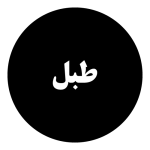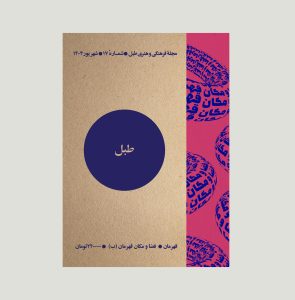First Season
Issue 06
Cold War – Cinema, Theater, Music (A)
September 2021
Content
– The Theater and Ballet Arts of Iran
Nilla Cram Cook
– Committed Theater in Iran
Laleh Taghian
– The Influence of 1953 Iranian coup d’état on the Formation of the Committed Screenplay Writing
Gholamhossein Dolatabadi
– The Emergence of Ballet in Iran and its Development
An interview with Haydeh Changizian
– The Theater of the 40s
Amir Kianpour
– Documentary Cinema
An interview with Mohammad Tahami-nejad
– Cinema in Cold War Conflict between East and West
Parviz Jahed
– The Role of Persian Speech in Movie Gross: the Development of Dubbing Studios
Ahmad Zhirafar
– We Were Looking at a Poster of Uncle Joseph When Someone Offered a McDonald Hamburger
Siavash Razmand
– Jazz in Iran
G. J. Breyley
– The First Symphonic Orchestra in Iran
Nickid Mirzayans
– The Influence of the Cold War and Russia on Iranian Music
An interview with Alireza Miralinaghi
Abstract
The sixth issue of Tabl magazine, published in September 2021 with eight articles and four interviews, explores Iranian cinema, theater, and music during the Cold War.
The main argument of the four first essays is based on theater and ballet. Being employed by the Iranian government in 1942, Nilla Cram Cook in an article titled “the Theater and Ballet Arts of Iran,” recalls her life and career in Iran by bringing examples of the Pahlavi era’s political censorship and the influences of Hollywood on people that led to ultimate prevention of domestic theater in Iran. She also explores the influences of the Soviet Union on theater artists and halls, the activities of the left-wing after the fall of the Tudeh Party, and the recreation of Iranian music along with the ballet. Finally, she mentions the viewpoints of those critics who explained the modernization of Iranian theater.
As for the lively spirit of performing arts, theater and translated screenplays were more influential on the political orientation of people than political literature. In a conversation with Laleh Taghian, on “Theater Influenced by its Actors Between 1324 to 1357,” she discusses the political progress of theater during Reza Shah’s reign, including the establishment of the Organization of Intellectual Development and efforts for developing art education. She considers the theater of the 1940s and the 1950s close to communism; a theater for sociological contemplation. Moreover, the rapid change of Iran from an ignorant to modern society, establishment and development of national theater, the extinction of Ta’zieh and Marionette, SAVAK’s censorships, the influences of the Faculty of Cinema and Theater of Tehran University of Arts and the Faculty of Dramatic Arts on the socio-political environment of Iran are other subjects that are discussed in this conversation.
Describing the historical and political foundations of the Iranian coup d’état, Gholamhossein Dolatabadi in his article “The Influence of 1953 Iranian coup d’état” gives a thorough explanation of the intellectual and literal circumstances of Iran’s society in poems, fiction, and drama, after the coup d’etat. The political freedom of the late 50s led to the Committed Playwriting in Iran that was inspired by three intellectual and philosophical concepts: Literal Commitment, Critical Thinking, and Back to Self. Along with being equipped with western technics and knowledge of playwriting, the writers of this movement attempted to reflect, interpret, and criticize their society for the first time. Anti-westernization being the main theme and idea in the works of intellectuals of this decade, namely Shadman and Al-e-Ahmad, is also explored in this article.
Describing the process of her ballet education and performances, Haydeh Changizian, Iranian ballerina, discusses “the Emergence of Ballet in Iran and its Development.” She recounts memories of getting acquainted with and being taught by Madame Yelena, her travel to Köln for learning ballet in an academic environment, and finally, going to the well-known Leningrad’s Vaganova Choreographic School to continue her professional education. She also mentions the difficulties she went through at the time of her return to Iran, because of her stay in the Soviet Union.
The main focus of the next four essays is on cinema, documentaries, and dubbing. In this regard, in a conversation with Mohammad Tahami-nejad, he discusses “the Documentary Cinema of Iran around the 40s and 50s.” Very few documentaries being produced in the 40s, for Tahami-nejad, this decade is the age of providing infrastructure and supplies for Iranian cinema. He refers to Koushan as the creator of documentaries in Iran and describes the activities and equipment of filming studios of the time. During the occupation of Iran by the Allies, Russia, Britain, and the United States entered Iran and in addition to recording their activities, made important documentaries in Iran that are also mentioned in this conversation. Finally, Tahami-nejad demonstrates the distinction between the 40s-50s and the 60s-70s that was made with fundamental technological changes that led to new genres in documentaries.
After World War II and the beginning of the Cold War, during 15 years of break, Iranian cinema was among the arenas of competition for the east and west. Therefore, movie halls were dedicated to American, British, and Russian movies. Parviz Jahed in “Cinema in Cold War Conflict between East and West” with a statistical study of the screened films of these countries, the number of movie halls that were dedicated to each country, the subject of their films, and their audience, compares the authority of these countries on Iranian cinema and therefore, their impacts on Iran’s society. Moreover, he points out the reactions of these countries to the activities of the opposing opponent.
After the emergence of cinema in Iran and establishing film studios, some of those studios discovered the important role of dubbing in box-office gross. Therefore, they started to import foreign films and attempted to dub them. The competition between the studios in dubbing films led to the improvement of dubbing quality in the 60s’ films. Along with augmenting the movie gross, the process of dubbing aimed to make changes in films to make them screenable. This functionality of dubbing is explained thoroughly in “the Role of Persian Speech in Movie Gross: the Development of Dubbing Studios,” by Ahmad Zhirafar.
In “We Were Looking at a Poster of Uncle Joseph When Someone Offered a McDonald Hamburger,” Siavash Razmand takes “A Look at Iranian Cinema and Music during the Cold War,” and their mostly vernacular themes, from the World War until the Islamic Revolution. He aims to clarify whether Cold War or international political arguments, had a direct influence on Iranian 20th-century art. Iranian art more than being international was based on a national platform for domestic presentations, in which, one could find traces of Xenophobia.
The last three articles focus on music. “Jazz in Iran,” being a summary of an article by G. J. Breyley, demonstrates the importance of this genre of music in connection to the west, as well as themes, such as modernizations, the concept of freedom, socializing through cooperation or co-working, identification with those being suppressed all around the world, and finally, with a sort of national and cultural expression, he studies the importance of Jazz through the combination of Iranian and regional music. In this article, Jazz in Iran is studied in three distinct historical periods: from 1925 to 1953, from 1953 until the Islamic Revolution, and the early years after the revolution.
The starting point of the historical process of the transformation of western classical music in Iran being of great importance, Nicky Mirzayans wrote a summary of professor Badmagrian’s memories of the true date of the first symphonic concert in Iran. Badmagrian recounts memories of Tabriz concert, his efforts to have a concert in Tehran, difficulties he encountered in receiving official permission for Armenian songs, gathering together a group of players in economical hardship, sold-out tickets, the crowded hall, and finally, his success in the concert. His concert in Tehran was done with almost 80 players on the stage and the presence of important figures in the audience. In this concert, he played two tracks from national Iranian music that were well-received by the audience.
In the end, there is a conversation with Alireza Miralinaghi on “the Influence of Cold War and Russia on Iranian Music.” The discussion starts with the 1940s and how ballet performances and classical Russian music influenced Iranian music. Miralinaghi describes the first Pahlavi dictatorship that, with the establishment of the Organization of Intellectual Development, controlled the publication of the poems and prose of the time. With the fall of suppressing organizations, the Tudeh Party gains power. In continue, Miralinaghi describes the works of Parviz Mahmood, who held music classes at the VOKS. He also points out the importance of the establishment of the Iran-Poland Cultural Society in the 1950s and how the cultural societies’ approaches changed. At the end of this conversation, he discusses the emergence of Pop music in Iran, from the second half of the first Pahlavi’s reign until the 90s.
“Opposing Imperialism” is a modern political concept that changed the Socialist and Communist discourses in Iran and is carved in the depth of Iranian’s historical consciousness. In “the Conceptual Turn of Anti-imperialism Struggles in Iran after the coup d’etat: from Marxism to Third Wordism,” Amir Kianpour starts the historical narration of anti-imperialism from the 1953 coup d’etat against Mosadegh’s government and Shah’s White Revolution. With their seemingly same intention, anti-imperialist and anti-capitalist ideas were torn apart and ultimately, a sort of anti-imperialist discourse became dominant that was no longer founded on social antagonism and class divisions and led to cultural, identity, and Islamic theories, such as works of Al-Ahmad or Back to Self by Shariati. The very same discourse continued after the Islamic Revolution in an anti-American approach.
Staff
Publication Rights and Editor-in-chief: Hooyar Asadian
Guest Editor: Mahsa Tehrani
Advisors to the Editor-in-chief: Borzoo Forootan, Peyman Pourhosein, Mohammad Tolouei
Copy Editors: Masih Azarakhsh, Atiyeh Assarpour
Proofreader: Roya Kiani
Internal Director: Roshanak Roshanaee
Executive Coordinator: Nasim Mousavi
Executive Assistant: Setayesh Nejadi
Art Director: Peyman Pourhosein (StudioKargah)
Uniform Design: Siavash Tasaodian
Design and Layout: Majid Asghari
Print and Production: Studio Tabl
Print and Production Supervisor: Hossein Soltani
Printed by: Shahrivar
Special Thanks to: Farzan Asadian, Safaeddin Emami, Kiyan Forootan, Mona Janmohamadi, Arash Sadeghbeigi, Mohammad Safarpour

